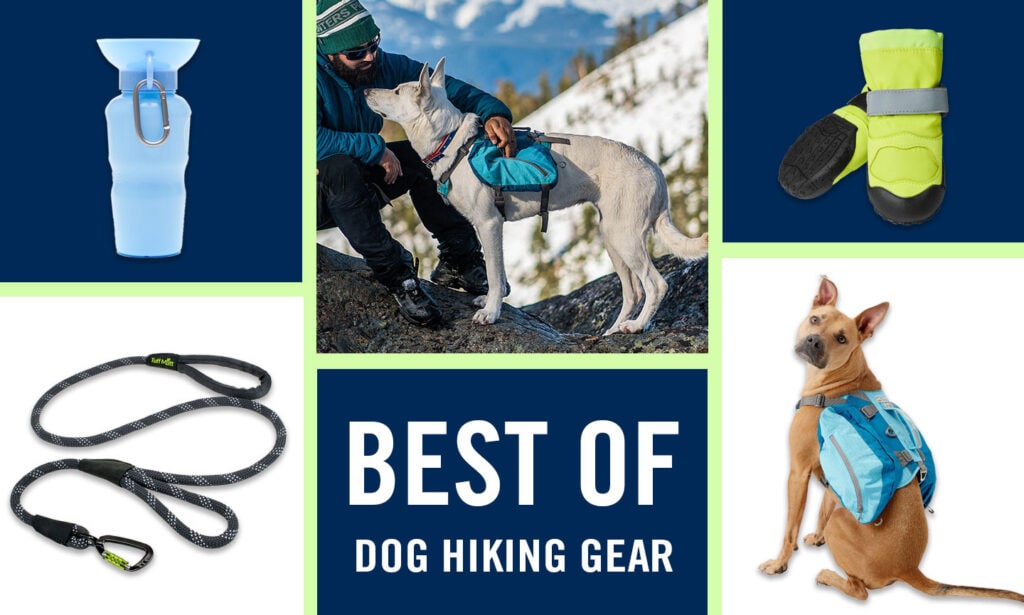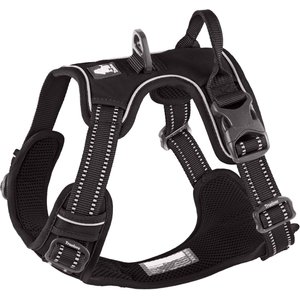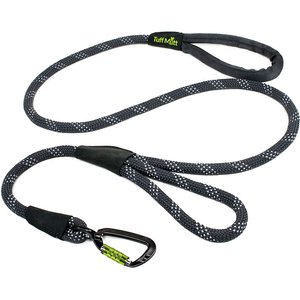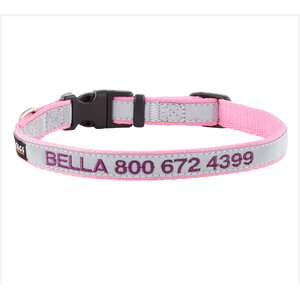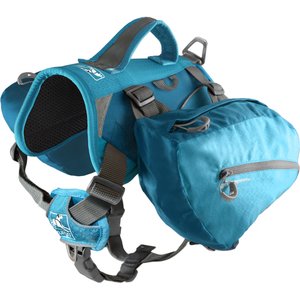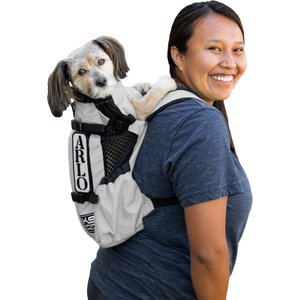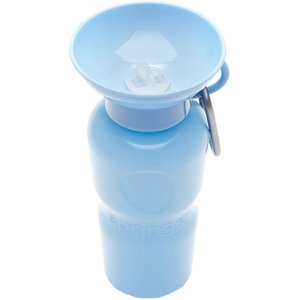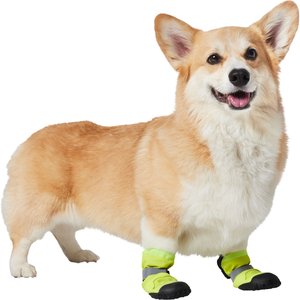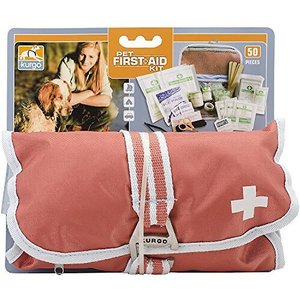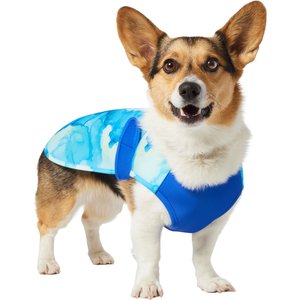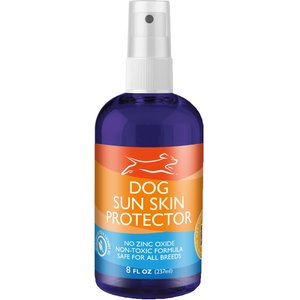Hiking with your dog is a great way to spend quality time together because it offers many benefits for you both. Not only is it a great cardiovascular and strength workout, but also a mentally enriching experience that gets both you and your pooch out of your normal routine and into the Great Outdoors and all of its beauty. Ready to hit the trail? With this comprehensive shopping guide, you’ll know exactly what to pack, and you’ll find the best dog hiking gear that other nature and dog lovers like you use.
- 1
- 2
- 3
-
4
$60 on ChewyFREE 1-3 day shipping
-
5
Best Dog Carrier Backpack for HikingK9 Sport Sack Air 2 Forward Facing Dog Carrier Backpack $75 on ChewyFREE 1-3 day shipping$75 on ChewyFREE 1-3 day shipping
How To Find the Best Dog Hiking Gear
Before you start shopping for dog hiking gear, there are a few things to consider to help you determine what you’ll need, including what’s a must versus a want. We spoke with Maria Christina Schultz, certified canine fitness trainer and owner of Maria Christina K9 Training, who regularly hikes with her Australian Shepherds, Bodie and Willow, for advice.
- The weather: Check the temp. Will it be hot? A cooling vest may be in order. And don’t just look up what the forecast is on the day you plan to hike, but also what may have occurred in the days prior. Rain can leave muddy and slick trails, as can melting snow, in which case dog boots may be needed. Seasonality comes into play too. Verify the local hunting seasons, and even if you’re hiking in a no-hunting zone, consider putting a brightly colored vest or jacket on your pup as an extra precaution, says Schultz.
- Your dog’s physical abilities: A dog’s age and breed don’t tell the full picture, says Schultz. Consider prior injuries, temperament and current fitness level to keep your dog out of harm’s way—and to make sure they actually enjoy themselves out there. What’s more, even athletic, well-conditioned dogs may have difficulty traversing trails with high elevation gains. A dog carrier backpack may help when your dog is unable to traverse the trail, or simply to give them a break from walking.
- Trail rules: Not only do you want to confirm the trail is dog-friendly, but you’ll also want to know if dogs are expected to be leashed.
- Length of hike: How long will you be out on the trail? This will help you determine what supplies you should bring, like food, water and bowls for each.
15 Best Dog Hiking Supplies
Below is the best dog hiking gear as tested and approved by Chewy customers. These best-selling, top-rated dog hiking supplies get two paws up from dog parents like you.
Best Dog Hiking Harness
-
GREAT Fit
This harness allows me to take Rosie for walks on the roads with no risk of her getting out of the harness as can happen with a collar. It is more comfortable for her as well.
-
Great customer service
Dog coat is perfect. Every time I've called chewy the staff has always been very helpful and knowledgable. Tha nks Chew
-
Nice harness
This fits my 32 pound pomsky great!! Feels very secure and he seems to be comfortable in it. I believe we got a medium
Best Dog Hiking Leash
-
Great product design
The double handle design and durability. This is our 2nd time purchasing this product only because the old one was dirty and our dog chewed on it a bit.
-
Great leash, really sturdy
I have 2 Great Pyrenees dogs and these leashes are strong enough for 100 lb dog, no problem. Just wish they had padded handles.
-
Best leash yet for my young, enthusiastic dog!
I love this leash. It is very strong, good for a dog that sometimes pulls pretty hard (we're working on it!) it's soft and thick enough that it's easy to hold onto, and the handle is especially nice. The second handle is also great and easy to grab when needed, and the sturdy carabiner clip also works great.
Best Dog Hiking Collar
-
Pretty in pink
The reflective strip REALLY works. The 3/8 inch width is nice, she is small boned and this suits her better.
-
Bright and sturdy
My big George wore the last one for about 3 years with his little 120 pound sister tugging and chewing on it along the way. I finally bought a new one once I realized it was mighty dirty! The clip always worked though and the reflective part never peeled off.
-
Cute and practical!
Cute and practical! I walk my pup with a harness but wanted something incase she got out. I like that its reflective and you can easily see her name/my number
Best Dog Hiking Backpack
-
Nice bag, sturdy and attractive
This bag fits my 50lb boxer great! It fits a water bottle on each side plus poop bags and my keys and phone. Easy to put on and I had no problem adjusting it.
-
Best Backpack
I have a 4 month old Boxer / Basenji Mix so not sure his future body size. He weighs 40 pounds so we figured to go with the big baxter so he can grow into it. Pack arrived. Made from strong material and looks good. Took me about 8 minutes to put straps all the way in for my small dog. Already works great & as he grows the pack will grow with him. Thank you
-
Great backpack
My mom just took me on a 125 mile backpack trip. I carried my own bowl, my food for the day, and a couple of other things. I am 60 pounds and tall and leggy (and very cute if I say so myself) and I was not sore at all!! She got me this pack because it had some back support. The straps didn’t rub me at all since they are back out of my armpits. And once when a huge elk ran right in front of us, so grabbed the handle and kept me from running like I thought I might like to. We did try a harness under it the first day so she could keep me on the leash, and it worked Ok, but that rubbed my arm pits so she just had to use a collar for the rest...
Best Dog Carrier Backpack for Hiking
-
Pup can go anywhere now!
Purchased this to take our Cavalier King Charles out around town when we bike (our primary way of getting around.) It was a great way to keep him off the ground before he was fully vaccinated, and has proved a great way to get him quickly & safely to the vet. It takes a bit of practice to get the pup settled and locked into place, but once you get the hang of it you'll get your pup in the bag in no time! Wanted to add that the company's customer service is top notch as well! They offer support if you have issues with the size of the bag, and our puppy managed to chew apart a buckle which they were willing to replace as well. Great product,...
-
Amazing product
Baker Beam was recently diagnosed with a luxating patella and we wanted to make sure she could still go! We got the K9 sack today and took a walk. She immediately got in with no issues. Her smile shows how much she loved it! Will most definitely upgrade this in the future because we expect a lot of use!
-
Perfect for biking
It was easy to get my dog in the back pack. She loved being able to be with me on a bicycle ride. My dog is about 19 pounds and it felt comfortable carrying her in the backpack. Highly recommend this backpack!
Best Collapsible Bowl
-
Best purchase I’ve ever made for my fur baby
The collapsible dish is very convenient. It is very easy to travel with and I love the fact that you unzip it and you have two bowls. It is very convenient.
-
collapsible
I really like this. We have 2 dogs and an RV. The collapsible feature comes in very handy. Space is limited in any RV.
-
Nice travel bowls
This is a handy travel bowl set. It zips for easy transport. There is a clip attached to a silicone ring that makes it easy to attach to a bag or pack.
Best Dog Water Bottle
-
Perfect water bottle for traveling
So easy to fill the cup part with water and very easy for my puppy to drink out of it. When she’s done drinking I let go and the water goes back into the bottle. Close the drain and no leaks!
-
Easy to Use
Replaced our previous water bottle with the Sprinter Travel. Bottle. So far so good. One feature that is particularly helpful is the ability to turn access to the water on and off through the top. No spills.
-
Accompanies us on every walk!
We absolutely love this water bottle. My dogs especially love how quickly the bowl part fills. I personally love the durability and how easy it is to squeeze when compared to other brands. No issues at all with this leaking- just make sure the middle plastic is turned off.
Best Dog Booties for Hiking
-
Not Right For My Dog's Need
There is nothing in the world wrong with these booties-which is why I gave 5 stars, but they aren't right for my dog. Titan has DM (Degenerative Myelopathy) and has lost the use of one of his back legs (so far) and uses a doggie "wheelchair" with all terrain wheels and loves going on long walks again. He hated the little sling that lifts his foot off the ground, so he drags it on the ground. I thought the next best thing would be a boot with a solid rubber toe so it would be durable enough to be dragged. Problem is, these aren't meant to be dragged. We got about 75 yards from the front porch and it was already off. It tightens on nicely and...
-
Blue’s Boots
These boots are great. We are only using one boot on a front paw. Our vet recommended we keep this paw clean and dry during visits outdoors while a nail cuticle skin condition heals. We measured Blue’s foot and used the sizing chart and got a perfect fit. These are well made and cinch up with a Velcro strap around the leg plus a drawstring at the top. These boots stay on even when Blue has a melt down when meeting other dogs!!
-
Durable and stay on well
These boots are awesome. The rubber on the bottom is sturdy and much better quality than others I’ve tried. Gives a lot of support. I also love love love that they have both a drawstring tie at the top of the booties as well as a Velcro strap to secure them. Having both keeps these on my dogs feet without slipping off. The material is not flimsy and seems to be durable for our walks in the rain. I just wish they had more colors.
Best Dog First Aid Kit for Hiking
-
Great Buy!!!!!!!
The only thing I had to add was a tick removal tool and this kit is complete. We have a travel cat and wanted to make sure we were ready for any emergencies on the trail. This kit does the trick and then some. Price was good, too.
-
Good First Aid Kit
This is a good first aid kit. It comes with most of everything you may need, plus has some space for extras you may want to add (I added Benadryl and Neosporin to the pack), and it doesn’t take up a lot of space so you can store it pretty much anywhere.
-
Perfect For Travel
This is a perfect first aid kit for traveling with our puppy! Luckily we haven't had to use it yet, but it seems to have plenty of helpful things in it!
Best Dog Cooling Vest
-
It looked great. Beautiful color and comfortable fit.
It is very lightweight. I was a little disappointed that it didn't stay wet longer. I soaked it in water and it did help to keep her cool. i had to soak it about every hour. But, maybe that was a good thing because i kept a closer eye on her.
-
Cools in Hit Days
This works well to keep my dog cool on her walks in the 2024 excessive summer heat of 109 to 115 degrees in Palm Springs CA.
-
Great Value
I ordered this for my dog due to extreme temperatures we are having this summer. It fit perfectly and holds the coolness pretty well. If was hiking my dog long distances, I might be inclined to buy the name brand version. For the price this product is excellent and I would highly recommend it.
Best Dog Poop Bags for Hiking
-
Thick!
These bags are the best. They're thick enough where I don't feel the "texture" of the poop. They're dark enough where you don't see thru them. I've tried a lot of brands and this is my favorite.
-
Earth Rated: The Eco-Friendly Poop Bag Game-Changer
I recently tried the Earth Rated Dog Poop Bags, and I’m thoroughly impressed! These compact, extra-long, and leak-proof bags are perfect for on-the-go dog owners, fitting easily in pockets or backpacks. Made from 65% certified post-consumer recycled plastic, they help divert over 5 million pounds of plastic from landfills each year, making them an eco-friendly choice. Plus, they tear easily from the roll and keep my hands clean while handling waste. If you're looking for reliable and environmentally conscious poop bags, Earth Rated is definitely the way to go!
-
Great bags
These bags are great. We always buy the box now because they have consistently been the best to use for us. Highly recommend.
Best Dog Treat for Hiking
-
Dense, chewy, and apparently tasty
Nice little treats, easy to store and easy to carry on walks. Not dry and crumbly, but not sticky for your pocket.
-
My dog loves them.
My dog loves these. I use them as a special treat after filing her toe nails and just for fun.
Best Dog Food Storage Container
-
Sturdy and well-designed
Just like any stuff sack for camping, but ensures your kibble is nice and safe (no ripped plastic grocery bags here), and seals up nicely.
-
big
we ordered the wrong one, this was way bigger than I thought it was and we couldn't use it so we gave it away. For someone wanting a very large container this would do the trick, we need a much smaller container.
-
Moose proof
We travel on a camper van. I appreciate how they size of the bag gets smaller as the food is eaten. Also after 5 years of travel the bags have held up like new. Best of all while mice have gotten into other bags we used for food storage, not these bags. Just leave enough space to roll them down 1 full turn.
Best Dog Sunscreen
-
Sun Screen For My Rescue!
My Malty has vulnerable pink underbelly areas, and this product seemed like a good idea. Janis doesn't even mind when I apply it!
-
Does well
The spray goes on well. Doesn't smell strong or bad. We use a cloth to apply to face, our dog hasn't been burned or turned red in the sun.
-
At ease spray
I feel comfortable knowing he gets by now with uv protection and I spray it all over him even his pads,I put on a long with mushers secret on his pads for the hottest day for his pads with vapor rub for if it could be extra protection for grounds being hottest by healing even if it's not rough but to prevent with the wax being melt moisturizer with protection being thick though it's thin and waxy on my hands his pads but I give him short walks anyway but when it's sneaky getting to be hottest not knowing it will when it's a long walk I still feel good that he's covered!!!
Best Hands-Free Dog Leash
-
waist leash
I have pain in my back and when my dog pulls on the hand held leash I have more pain. the waist lease evenly distributes the weight making the walk more pleasurable.
-
Versitile
I got this for running but use it a lot for walking. The handle placement is perfect for gaining more control when I need a short leash but the length is great for walks when we are just strolling or running.
-
Effective Design
We have a 6 month old 50 lb pit/healer who pulls almost as bad as my 100 lb Bluetick (if you know you know). I have always used these types of leashes with my bluetick and I saw the design of this one with the two extra handles and thought it would be great for the puppy. It is very strong, durable, well-made, and those two extra handles helps tremendously with control. I bought one for each dog
How We Chose These Products
Hiking with your dog is all about experiencing what nature has to offer together, and the right dog hiking gear can help get you on the trails faster and with more confidence. That’s why we consulted our experts, who spend tons of time with their own pets outdoors, to understand what types of products are needed for hiking with dogs. Then, we combed through Chewy’s best-selling products to bring you only those that have a minimum rating of 4 stars from customers. This way, you can be sure you’re getting dog hiking gear that is pet-tested and pet parent–approved.
What Do I Need To Go Hiking With a Dog?
Now that you know what the best gear is for your next hiking trip with your dog, let’s walk through the different types of dog gear in more detail to better understand how they can improve safety and comfort, and simply make the experience more enriching and enjoyable for you both.
Dog Harness
Always ensure your dog has a well-fitted harness that doesn’t inhibit their natural gait or range of motion, says Schultz. Be mindful of harnesses with a horizontal strap in front that could inhibit a dog’s shoulder extension, which could prove tricky while maneuvering across terrain on hikes, she adds. A harness with a handle on the back is a nice option if you think you may need to hoist your dog over or up something on the trail, as well.
Portable Water Bowl or Bottle
Hydration for you and your dog throughout your hike is essential, so products that provide easy access to drinking water are a must. “A general rule of thumb for dogs—without strenuous activity in mind—is to drink approximately 1 oz. of water per pound of body weight per day,” says Maggie Peikon, manager of communications at American Hiking Society, who hikes weekly with her dog, Finley, a 10-year-old Standard Schnauzer. “With hiking in mind, you’ll want to be sure you have more than enough water to accommodate your dog’s needs during a physically demanding outing.” A collapsible dog bowl is a great space-saving solution, and water bottles with good leak protection or those with a spout for easy drinking are smart choices as well.
Leash
Whether you opt for a longer lead to give your dog a little sense of freedom or the trail rules or environment necessitate a short leash, choosing a style that is well-made and sturdy is important when hiking with your dog. “A leash with a strong clip is always a good idea,” says Peikon. “You never know what you may encounter on the trail, and ensuring your dog’s safety is essential.” For hikes and other outdoor activities, some pet parents opt for a hands-free leash that wraps around their waist or chest to keep their own hands free, but if your dog tends to pull on a leash this may not be the best choice, she says.
Food and Snacks
Water. Check. Food. Check. For longer hikes or if you know your dog may need a little savory encouragement, packing a small baggie with kibble or some treat isn’t a bad idea. You know how the hunger pangs thwart even the best-laid plans, so don’t get caught out midway through a hike with a grumbling stomach—and that goes for either of you. A small reusable baggie or a travel dog food container should do the trick.
Poop Bags
“Always remember to leave no trace,” says Peikon, referring to the initiative to keep nature in its, well, natural state. That includes granola bar wrappers from you and poop and waste-filled bags from your pup. In addition to making sure you have plenty of poop bags, consider adding something to your pack to carry the used waste bags out of the park, says Peikon.
“Not all trails will have garbage bins, so having a way to carry out your dog’s waste, such as a carabiner clip or this pouch bag from KONG, is essential—leaving it on the side of the trail is not an option,” she says. (You never want to leave waste on the ground, as that could spread bacteria or disease; not to mention, it’s unpleasant for fellow hikers.)
Other Dog Hiking Gear To Consider
These are a few other nice-to-have items to consider adding to your cart before checkout:
- Dog bug spray: A mosquito repellent may come in handy in dense, or humid, environments. This one from Vet’s Best comes highly rated by Chewy customers.
- GPS tracker: If you’re interested in keeping an eye on your dog’s movement for fitness purposes or mileage on the trail, a GPS activity tracker could be a handy tool. Just don’t rely on these gadgets instead of recall cues when you need your dog to return to you, as they need cellphone service to work—a limited commodity while hiking, says Schultz.
- Tent: A tent is a must if you’re planning to hike to a campsite for an overnight in the backcountry. Bring a foldable dog mat or thin dog bed for your dog to sleep on alongside your sleeping bag inside the tent with you, says Schultz. This travel dog bed from Frisco by Chewy is a good option.
- Light-up collar: In low-lit areas, during dusk or at night, an easy-on, easy-off light-up collar is a great way to keep your pup in sight. This rechargeable LED collar from Blazin is one option to try.
Benefits of Hiking With Your Dog
In addition to the obvious physical benefits, hiking with your dog also has mental health benefits.
“When we travel [or] go someplace new, we feel refreshed and invigorated when we get back,” says Schultz. The same is true for our dogs. “For a dog, who typically only gets to walk around their neighborhood and smell the same mailboxes every day, it just changes things up for them,” she says.
Plus, it’s a chance to strengthen your relationship, says Peikon. “Hiking provides social benefits, both for you and your pet, to bond through quality time together and for your pet to experience social interactions with other hikers and hiking dogs,” she says.
Tips for Hiking With Dogs
- Start small. “The best way to start hiking with your dog is simply to head out and go,” says Peikon. But you want to “start small, start local and see how the experience goes.” The life stage of your dog can impact the distance, terrain and elevation they can safely hike, as well, says Schultz. Puppies and seniors shouldn’t be on strenuous or lengthy trails.
- Double-check that a trail is dog-friendly. Ask local guides and browse forums for images and insider info, says Schultz. A trail may be labeled dog-friendly because it allows dogs, but that doesn’t necessarily mean the terrain is suitable for dogs (think: extreme inclines, steep drop-offs or very rocky trails). While you’re researching, “ensure that you know the leash laws in the area, and adhere to them,” adds Peikon. “This is for your safety, your dog’s safety, the safety of other hikers and their pets, as well as the environment you’re hiking and the wildlife that call it home.”
- Always be prepared. Have a plan for the unexpected, such as if your dog is injured. Pack a portable first aid kit, and “always have a plan for how to carry your dog off a trail during a hike,” says Schultz. She recommends having (and practicing with) a dog rescue harness on hand, which has a sling-like design to hold a dog’s weight with straps to carry the dog like a backpack. You may also want to pack some extra kibble for them and a snack for you to maintain energy as the miles increase. Plus, “you have to think about the weather where you’re hiking,” says Schultz. “Is your dog going to need a jacket or a coat? I’m also a big fan of cooling jackets or a bandana [for hot days].”
Have more hiking questions? Check out this ultimate guide to hiking with dogs, which covers everything from finding a dog-friendly trail to safety tips to trail etiquette.
Hiking With Dogs FAQs
Q: Is it OK to take a dog hiking?
A: Yes, but there are some caveats. Before heading out, make sure your dog is physically capable and up for a hike (get a vet’s opinion if you have questions), and build up their cardiovascular stamina before venturing out for a lengthy trail, says Schultz. And don’t forget about practical factors like checking for inclement weather, dog-friendliness of a trail, and even local hunting or wildlife seasons, she adds. Everything look good? Happy trailing!
Q: How many miles can you hike with a dog?
A: There’s no hard-and-fast rule for how many miles your dog can safely hike. It really comes down to the physical conditioning of your dog, says Schultz. How conditioned (think: endurance, strength, orthopedic health, their paw pads, etc.) a dog is will help determine the distance they can travel. But climate, terrain and elevation all make a difference, too, she says. And when in doubt, “less is always better until you build up their stamina,” she says.
Q: Do dogs like going on hikes?
A: Not all dogs will enjoy hiking, and some may start out strong but have their limits. The key to knowing where your dog falls is being attuned to their stress signals, says Schultz. Typical signs include yawning, trembling, lip licking and not wanting to move. Your dog may stop, sit or even lie down on the trail if they don’t want to continue on, she says. The bottom line: If hiking isn’t your dog’s thing, never force them.
Q: How to carry your dog on a hike?
A: If you’re interested in carrying your dog during a hike in a backpack, for example, you should make a few key considerations, says Schultz. Are you physically able to carry your dog? Larger breeds will certainly be more difficult to carry for longer periods, not to mention they will likely be quite uncomfortable, she says. “Dogs’ bodies are designed to be horizontal,” she says. “We’re asking them to be vertical in a backpack.” So, you’d want your dog to be able to comfortably sit in a carrier or backpack that has strong support and padding. If you have a smaller dog who can move around comfortably in a well-designed, joint-friendly backpack, you can test it out on shorter distances at first, and go from there, says Schultz. Otherwise, stick to what distance they can cover on foot or leave them at home.
Ready to hit the trails with your pup? Feel prepped and ready for anything with our “best of” list for all your dog hiking gear needs, so you both have a safe and enjoyable time in the Great Outdoors. Looking for your next adventure? Check off some epic destinations from these best dog-friendly hikes in all 50 states.
Expert input provided by Maria Christina Schultz, CCFT, owner of Maria Christina K9 Training based in central Virginia; and Maggie Peikon, manager of communications at American Hiking Society, based in Moab, Utah.
More outdoor adventure advice:
Share:
